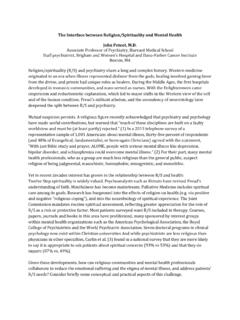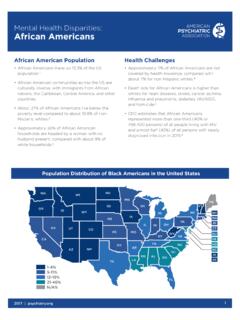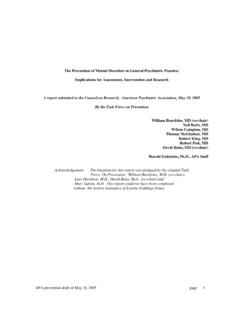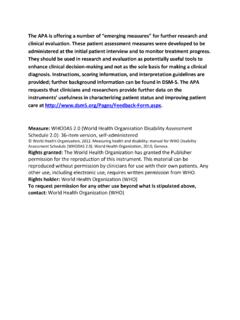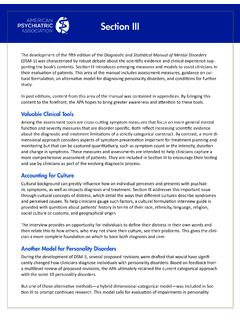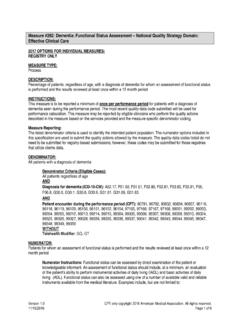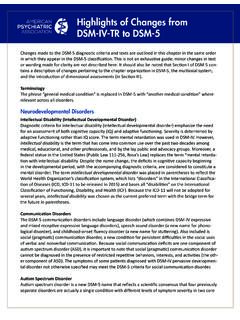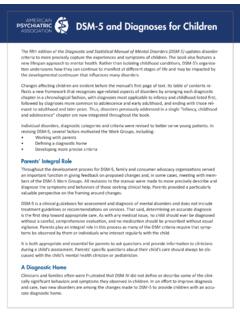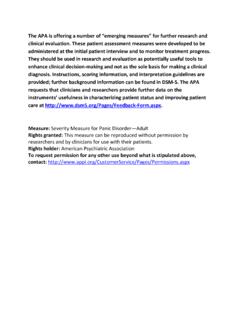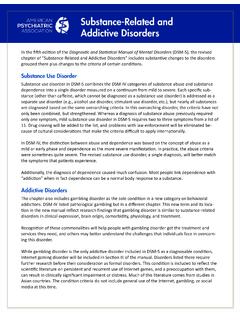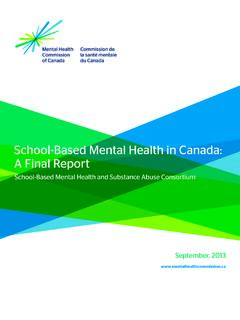Transcription of Mental Health Disparities: Diverse Populations
1 Mental Health Disparities: Diverse Populations Mental Health in US Population: Race/Ethnicity Approximately 18% of US adults have a diagnosable Mental disorder in a given year, US Population, 2016. and approximately 4% of adults have a serious Mental illness. 1 Hispanic Mental and behavioral disorders are among White the leading causes of disability in the , accounting for of all years of life lost to NH/OPI. disability and premature death. 2. Mental disorders are among the top most Black costly Health conditions for adults 18 to 64 in the , along with cancer and trauma-related disorders.
2 3 Asian An estimated 43% of people with any Mental AI/AN. illness receive Mental Health treatment/ counseling. 4. Source: US Census. Quick Facts: Population Estimates 2016. Increasingly Diverse Population and-trauma (Notes: AI/AN American Indian/Alaska Native, NH/OPI . Native Hawaiian/Other Pacific Islander). The population is continuing to become more Diverse . By 2044, more than half of all Americans are projected to belong to a minority group (any group other than non-Hispanic White alone). 5. Mental Health , Diverse Populations and Disparities Most racial/ethnic minority groups overall have People who identify as being two or more similar or in some cases, fewer Mental disorders races ( ) are most likely to report any than whites.
3 However, the consequences of Mental Mental illness within the past year than any illness in minorities may be long lasting. other race/ethnic group, followed by American Indian/Alaska Natives ( ), white (19%), and Ethnic/racial minorities often bear a black ( ). disproportionately high burden of disability American Indians/Alaskan Natives report resulting from Mental disorders. higher rates of posttraumatic stress disorder Although rates of depression are lower in and alcohol dependence than any other ethic/. blacks ( ) and Hispanics ( ) than racial group.
4 In whites ( ), depression in blacks and White Americans are more likely to die by suicide Hispanics is likely to be more persistent. 6. than people of other ethnic/racial groups. 2017. Mental Health problems are common among Disparities in Mental Health people in the criminal justice system, which Service Use has a disproportionate representation of racial/. ethnic minorities. Approximately 50% to 75% People from racial/ethnic minority groups are less of youth in the juvenile justice system meet likely to receive Mental Health care. For example, in criteria for a Mental Health disorder.
5 7 2015, among adults with any Mental illness, 48% of whites received Mental Health services, compared Racial/ethnic minority youth with behavioral with 31% of blacks and Hispanics, and 22% of Health issues are more readily referred to the juvenile justice system than to specialty primary care, compared with white youth. There are differences in the types of services Minorities are also more likely to end up in the (outpatient, prescription, inpatient) used more juvenile justice system due to harsh disciplinary frequently by people of different ethnic/racial suspension and expulsion practices in groups.
6 Adults identifying as two or more races, Lack of cultural understanding by Health care whites, and American Indian/Alaska Natives were providers may contribute to underdiagnosis more likely to receive outpatient Mental Health and/or misdiagnosis of Mental illness in services and more likely to use prescription people from racially/ethnically Diverse psychiatric medication than other racial/ethnic Populations . Factors that contribute to these groups. Inpatient Mental Health services were kinds of misdiagnoses include language used more frequently by black adults and those differences between patient and provider, reporting two or more races.
7 Asians are less likely stigma of Mental illness among minority to use Mental Health services than any other race/. groups, and cultural presentation of symptoms. ethnic Among all racial/ethnic groups, except American Indian/Alaska Native, women are much more likely to receive Mental Health services than Any Mental Illness in the Past Year among Among People with Any Mental Illness, Percent Receiving Services, 2015. Any Mental Illness in the Past Year among Adults, by Adults, by Race/Ethnicity, Race/Ethnicity, 2008-2012 2008-2012. Annual Average Percentage and 95% Confidence Intervals Among People with Any Mental Illness, Percent Receiving Services, 2015.
8 48%. 50% 46%. 40%. 31% 31%. 30%. 22%. 20%. 10%. 0%. White Black or American Asian Two or Hispanic White Black Hispanic Asian 2 or more African Indian or More American Alaska Native Races Source: Substance Abuse and Mental Health Services Administration. Source: Substance Racial/Ethnic Abusein and Differences Mental Mental Health Health Service Service Use Administratio., among Adults. 2015. Source: Substance Abuse and Mental Health Services Administration. Racial/Ethnic Differences in Mental Health Service Use among Adults. 2015 National Survey on Drug Use and Health .
9 2008-2015. 2017. Barriers to Care Factors affecting access to treatment by members To learn about best practices for treating Diverse of Diverse ethnic/racial groups may include: Populations and to get answers to your questions by leading psychiatrists, please visit APA's Lack of insurance, underinsurance Cultural Competency webpage at https://www. Mental illness stigma, often greater among minority Populations Lack of diversity among Mental Health care providers Lack of culturally competent providers Language barriers Distrust in the Health care system Inadequate support for Mental Health service in safety net settings (uninsured, Medicaid, Health Insurance Coverage other vulnerable patients).
10 2017. Footnotes 1. National Institute of Mental Health . Any Mental Illness Among US Adults. 2 . NIMH. Leading Categories of Diseases/Disorders. shtml 3 . Agency for Healthcare Research and Quality. Statistical Brief # 471 Top Five Most Costly Conditions among Adults Age 18 and Older, 2012: Estimates for the Civilian Noninstitutionalized Population, April 2015. 4 . Substance Abuse and Mental Health Services Administration. National Survey on Drug Use and Health . 2016. 5 . US Census. Projections of the Size and Composition of the US Population: 2014 to 2060.
